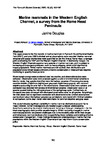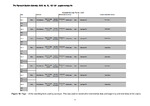Marine mammals in the Western English Channel, a survey from the Rame Head Peninsula
| dc.contributor.author | Douglas, J. | |
| dc.date.accessioned | 2022-12-23T19:47:37Z | |
| dc.date.available | 2022-12-23T19:47:37Z | |
| dc.date.issued | 2022 | |
| dc.identifier.citation |
Douglas, J. (2022) 'Marine mammals in the Western English Channel, a survey from the Rame Head Peninsula', The Plymouth Student Scientist, 15(2), pp. 163-192. https://doi.org/10.24382/kq6f-0x30 | en_US |
| dc.identifier.issn | 1754-2383 | |
| dc.identifier.uri | http://hdl.handle.net/10026.1/20118 | |
| dc.description.abstract |
This paper presents the first records of marine mammals in Plymouth Sound National Marine Park (NMP), and over 1000 individual animal observations were recorded. Marine mammal temporal and spatial distributions were quantified for the first time at Rame Head, a vantage point overlooking the NMP and the Western English Channel. A biodiversity hotspot, the Western English Channel supports many species of marine mammals, yet it is subject to increasing anthropogenic pressures, such as heavy shipping, which could significantly impact populations. Whilst marine mammals are well studied, their distributions and population sizes remain largely unknown; effective conservation of these animals requires monitoring to quantify these patterns. Shore-based surveys were conducted over two months, and observational data were collected. Observation rates were analysed against a suite of environmental variables to identify trends. Key species identified were the harbour porpoise (Phocoena phocoena), common dolphin (Delphinus delphis) and grey seal (Halichoerus grypus), with common dolphins accounting for over half of the observations. Observation rates were variable, and correlation was detected with several environmental variables. Observation rates of all species peaked during the mid-cycle phase of the spring/neap cycle. Furthermore, an increased sea state correlated with decreased observation rates for all species. Surprisingly, the tidal phase had no significant correlation with observation rates. Limited assumptions can be drawn about the harbour porpoise as correlations were found with minimal variables. In comparison, some clear trends were identifiable for common dolphins and grey seals. This study indicates significant variability in marine mammal distributions around Rame Head; however, further investigations are needed to gain a deeper understanding. Specifically, extending the study’s timeframe and including a thorough investigation into the local oceanography could provide valuable insights. While monitoring changes in marine mammal populations can present challenges due to the instability seen within their ranges and behaviours, we must dedicate effort to quantifying these variables and enabling effective conservation management. These findings increase our understanding of marine mammal populations within the Western English Channel and can help inform future conservation policy. | en_US |
| dc.language.iso | en | en_US |
| dc.publisher | University of Plymouth | en_US |
| dc.rights | Attribution 3.0 United States | * |
| dc.rights.uri | http://creativecommons.org/licenses/by/3.0/us/ | * |
| dc.subject | Marine | en_US |
| dc.subject | Mammal | en_US |
| dc.subject | Survey | en_US |
| dc.subject | Visual | en_US |
| dc.subject | Western English Channel | en_US |
| dc.subject | Rame Head | en_US |
| dc.subject | dolphins | en_US |
| dc.subject | grey seals | en_US |
| dc.subject | porpoise | en_US |
| dc.subject | harbour porpoise | en_US |
| dc.subject | Delphinus delphis | en_US |
| dc.title | Marine mammals in the Western English Channel, a survey from the Rame Head Peninsula | en_US |
| dc.type | Article | en_US |
| plymouth.issue | 2 | |
| plymouth.volume | 15 | |
| dc.identifier.doi | https://doi.org/10.24382/kq6f-0x30 |




